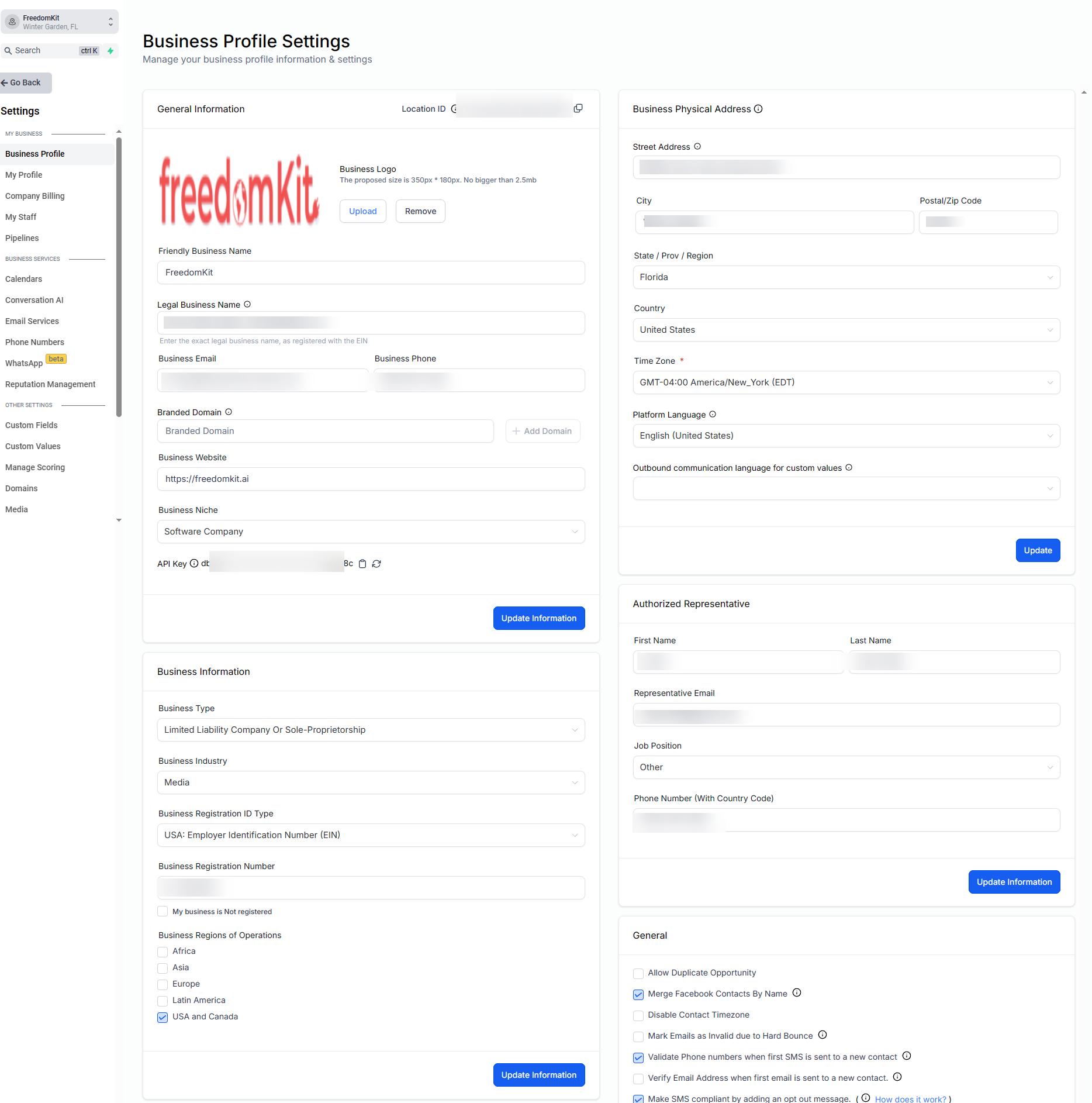In this article, we are going to answer a very common question: How many businesses can function properly inside a single Freedomkit.ai account.
Freedomkit's design
By design, Freedomkit is designed to work for a single business. However, depending on your circumstances, you may be able to operate several brands or businesses with a single account.
Let's first cover a couple of definitions.
What is "a business"?
Inside Settings > Business Profile, you'll have access to manage all your business profile settings. Here's a quick look at what you can manage inside:

These settings are the "big picture" business settings - your business address, registration numbers, and other information that may be required for taxes or other business reasons.
Each Freedomkit account can only have one business profile.
So if you decide to open 2+ LLC's or have multiple addresses for different businesses, it would be wise to open a separate Freedomkit account for the new business.
What is a "Brand?"
Many customers ask us if they can run multiple "businesses" - but after a few questions, it's clear they simply want to launch a new brand. And you can absolutely manage multiple brands inside a single Freedomkit account.
For a working definition, we can think of brands as a unique set of websites, automations, workflows, products, courses, services, etc, which roll up into a specific business.
For example, you might have one Business named Heidi's bake shop.
Heidi's bake shop as a business has the following assets:
- Payment Processor (like Stripe)
- A company EIN for tax purposes
- A business phone number for support
But within Heidi's bake shop, she could have 2 different brands.
Brand 1: Heidi's Brownies - a physical product shop that delivers delicious brownies to your doorstep.
Brand 2: Cook with Heidi - a digital course brand where you learn how to bake delicious brownies
Each brand will have a unique set of "assets" that help the brand operate and make sales.
Brand 1: Heidi's Brownies Assets
- Website (browniestore.com)
- Funnels (Save 10% of your first brownie discount)
- Automations (Leave a review and get a free brownie!)
Brand 2: Cook with Heidi Assets
- Website (cookwithheidi.com)
- Funnel (Free cooking lesson)
- Automations (Save 30% off my best selling cooking course)
- Memberships (Cooking community & cooking courses)
While these brands can look and operate completely separately, there will be some overlap. Each brand is going to belong to the same business meaning that they will share:
- The same business profile settings
- The same Stripe account (or other payment processor)
The downsides of managing multiple brands inside a single Freedomkit account
From the above example, it's totally acceptable to manage both brands inside a single account. But please be aware of the following potential downsides:
1 - List management
When managing multiple brands, you'll want to tag and manage you subscribers carefully to maintain a high sending reputation. For example, if you want to email everyone about a new upcoming cooking course, you might NOT want to email everyone who has purchased from your physical store before.
The risk here is if you email from a new brand, new email address, etc - your recipient may not recognize you, and this could lead to a greater spam rate.
The solution? Simply keep an organized set of tags to ensure you always contact the right subscribers.
2 - Multiple Blogs
Freedomkit's easy to use blogging tool was designed to be much simpler and easier to manage than a WordPress site. As a result, one of the simplifications is that all your blog posts are centrally managed:

As a result, it would be difficult to manage multiple blogs within the same account. You would have to categorize your content and get creative with displaying your posts, and that might not be worth it.
3) Multiple Stores
Similar to blogs, Freedomkit is designed to give you unlimited products within a single store. You can manage by using the Store functionality for your primary brand, and use funnels for secondary brands, but it may be better to simply have an account for each store if you plan on offering many products.
Conclusion
I hope this guide helps explain the pros and cons of combining accounts vs having separate accounts for each brand inside your business. If you ever decide to purchase an additional account, our team will be happy to help walk you through the process of migrating content to your new brand!